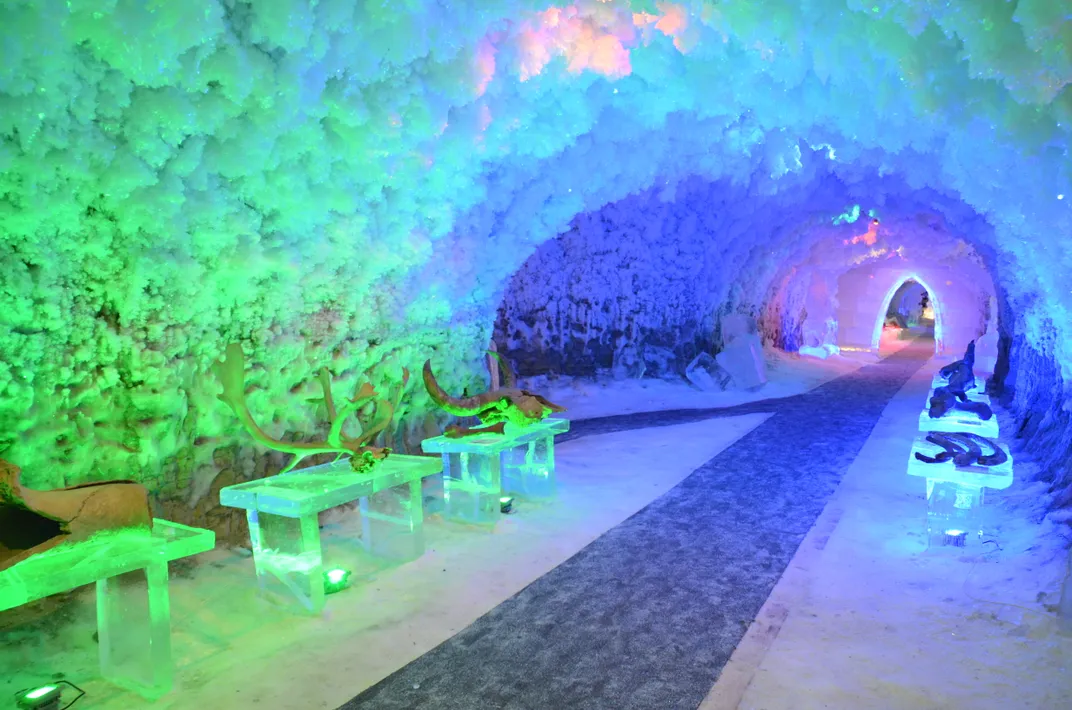Ice Age Cave Lion Cubs and a Look Back at Permafrost Mummies
A recent find in Siberia is the latest on a list of well-preserved Ice Age mammals
/https://tf-cmsv2-smithsonianmag-media.s3.amazonaws.com/filer/17/c7/17c7cbbf-4d4d-49db-a9d1-9f7b243f8f82/yuka_mammoth.jpg)
Like a natural deep freezer, permafrost—or permanently frozen ground—can preserve organic matter for thousands of years. As the permafrost melts, it releases some amazing finds that are often in immaculate condition. The most recent discovery of these icy creatures is sure to melt hearts: Two baby cave lions have been found in Russia’s Sakha Republic, reports Anastasia Koryakina for The Siberian Times.
The now extinct cave lions roamed the world between 10,000 and 300,000 years ago. Their bones and tracks have been found in caves and permafrost throughout Eurasia and North America. The critters were first described and named in 1810, yet researchers still debate how many species there were and where they belong in the family tree—were they a type of African lion or actually a tiger species?
In June, researchers reported on an incomplete but beautifully preserved adult cave lion skeleton that washed out of permafrost by the Malyi Anyui River in Russia. Researchers dated the lion using its bones and claws and discovered it was just over 61,000 years old, Viviane Richter reports for Cosmos.
Though scientists are currently working to date the recently discovered cubs, they believe them to be at least 10,000 years old, Koryakina writes. But the exquisite preservation of these cubs—much greater than that of the lion—may be a first. A photo of one cub, carried by The Siberian Times, shows yellowish fur covering a frost rimmed skull.
"As far as I know, there has never been a prehistoric cat found with this level of preservation, so this is truly an extraordinary find," says Des Moines University fossil felid expert Julie Meachen, in a National Geographic story by Brian Switek. “I was a little in disbelief when I first saw it, but when it looked to be true I was just in awe."
The researchers who discovered the cubs still haven’t released many details to the public, instead they await a November 17 press conference about the find. At that time, the cubs will be on display along with other Ice Age mammals at the "The Kingdom of Permafrost" in Sahka, also called Yakutia.

In the meantime, aficionados of Ice Age beasts can stave off impatience by considering other famous permafrost finds. These carcasses are often more exciting that the average ancient fossil or mummy because the low temperatures of the permanently frozen ground preserves tissues and hair to an unrivaled degree.
In 2011, David Bressan reported for Scientific American that at least 16 species of ice age mammals have been found around the world preserved as mummies—though this count also includes a woolly rhinoceros and mammoth that were pickled in salty groundwater, and other natural mummies from tar pits and bogs. He writes:
Some of the best preserved and oldest natural mummies were found in thawing permafrost in Siberia, Alaska and Canada: like the 40.000 year old Russian mammoth calf "Dima" (discovered in 1977) or the 36.000 year old bison "Blue Babe" (discovered in 1979) from Fairbanks (Alaska) and a 40.000 year old black-footed ferret from the Yukon territory.
Siberia, however, is the source of many recent finds.
One such find was a female woolly mammoth, now nicknamed Yuka. The body survived the 39,000 years entombed in permafrost so well that her brain, "with folds and blood vessels visible," remained mostly intact, writes Agata Blaszczak-Boxe for Live Science. That find revealed that mammoths had brain structures similar to their modern-day relatives, the elephants.
Yuka’s body also bore unhealed cuts perhaps from a cave lion and a long straight cut with marks in a "repeating ladder pattern" that may have come from human tools. Those marks led at least one researcher to suggest that the human may have tried to scare off lions trying to make a kill, reports Nic Fleming for the BBC.
Stomach contents may be preserved too, which not only yields information about ice age diets but also about the diversity of ice age animal populations.
The cubs are also not the only baby critter to be found in Siberia’s permafrost. One researcher involved with the cubs, Albert Protopovo of the Sakha Republic Academy of Sciences, also cares for the only baby wolly rhino carcass ever found. Two hunters discovered the rhino on the bank of a stream, Anna Liesowska writes for The Siberian Times.
"We were sailing past a ravine and noticed hair hanging on the top of it," says Alexander Banderov, one of the hunters. "At first we thought it was a reindeer's carcass, but after it thawed and fell down we saw a horn on its upper jaw and realized it must be a rhino. The part of the carcass that stuck out of the ice was eaten by wild animals, but the rest of it was inside the permafrost and preserved well."
Brain tissue and stomach contents would be high on the wish list of researchers studying the cave lion cubs. If the cubs still had mother’s milk in their stomachs, scientists could even deduce what the adult lions would have been eating, Meachen told Switek.
In their beautifully preserved bodies, these cubs just may hold the answers to many burning questions about the frigid world in which they once lived.